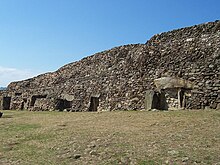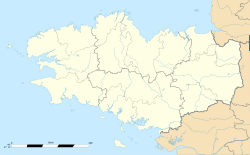Barnenez
 Front of the Barnenez cairn | |
| Location | Finistère, Brittany, France |
|---|---|
| Coordinates | 48°40′03″N 03°51′31″W / 48.66750°N 3.85861°W |
| Type | Monument |
The Cairn of Barnenez (also: Barnenez Tumulus, Barnenez Mound; in
History


Dates
Radiocarbon dates indicate that the first phase of the monument was erected between 4850 and 4250 BC, and the second phase between 4450 and 4000 BC.[3]
Secondary use
Pottery found in and around the monument indicates that it underwent a period of reuse in the Bronze Age, in the 3rd millennium BC.
Recognition as an ancient monument
The cairn was first mapped in 1807, in the context of the
Quarry damage
Privately owned until the 1950s, the cairn was used as a quarry for paving stones. This activity, which threatened to destroy the monument, was only halted after the discovery of several of its chambers in the 1950s. The local community then took control of the site.[3]
Restoration and excavation
The cairn was restored between 1954 and 1968. At the same time, vegetation was removed from the mound and systematic
The monument

The mound

Today, the Barnenez cairn is 72 m long, up to 25 m wide, and over 8 m high. It is built of 13,000 to 14,000 tons of stone. It contains 11 chambers entered by separate passages. The mound has steep facades and a stepped profile. Several internal walls either represent earlier facades or served the stability of the structure. The cairn consists of relatively small blocks of stone, with only the chambers being truly megalithic in character. The monument overlooks the Bay of Morlaix, probably a fertile coastal plain at the time of its erection.

Construction phases
The monument is the result of at least two phases of building.
Cairn 1, before 4500 BC
In a first phase, a slightly trapezoidal mound of 32 m by 9 to 13 m was erected. It contained 5 chambers and was surrounded by a double kerb. The first phase favoured the use of
Cairn 2, c. 4200 – c. 3900 BC
In a second phase, an extension with six further chambers was added in the west. At the same time, Cairn 1 was enveloped in a wider and taller structure; its passages had to be extended. More granite was used in this phase.[5]
The chambers
The 11 chambers of the Barnenez cairn are of the type known as Dolmen à couloir in French archaeological terminology. The term translates roughly as "passage grave". They are built of large slabs of slate and granite. Originally, all the chambers were entirely enclosed by the mound. The fact that several of them are partially exposed now is the result of modern quarrying.
Each of the 11 chambers is reached from the southeast via a long narrow passage (7–12 m long). They are arranged parallel to each other. Shapes and construction techniques differ slightly.
In nine cases, narrow passages lead to

Logistics
One cubic metre of the Barnenez cairn contains 1,500 kg of stone. It is estimated that the quarrying, fashioning, transport and construction of such an amount represents about four work days for a single worker (assuming a 10-hour day). The original monument, Cairn 1, had a volume of about 2,000 cubic metres; it is built of 1,000 tons of granite and 3,000 tons of dolerite. It would thus have required 15,000 to 20,000 working days; in other words, it would have taken 200 workers three months to erect Cairn 1 alone. In its final form, the Barnenez mound is nearly three times as big as the first phase.

Engraved symbols
Engraved symbols occur in several of the chambers and passages. They depict bows, axes, wave symbols or snakes and a repeated U-shaped sign. One of the carved slabs is in secondary use; it was originally part of a different structure, an interesting parallel to the situation in several other such monuments, including Gavrinis.
The symbols on the engraved blocks resemble those found in other megalithic monuments in Brittany; in broader terms they belong to the cultural phenomenon described as
Finds
Material from the original period of use
Only Cairn 2, namely chambers A, C and D, contained
Bronze Age pottery
Pottery shards found outside the monument indicate that it was reused in the Bronze Age (3rd millennium BC). A copper dagger and a barbed arrowhead are of Chalcolithic date.[7]
Comparable monuments
Similar, possibly contemporary, monuments are known at 22 other locations in France and on
Exhibition
An exhibition in the modern entrance building explains the results of scientific excavation and displays some objects from the site.
See also
References
- ^ "The world's 10 oldest ruins". The Telegraph. 4 February 2016. Retrieved 2016-06-29.
- OCLC 470171420.
- ^ ISSN 0021-8286.
- ^ "Restauratie van megalithische monumenten".
- ^ a b c "Great Cairn of Barnenez" (PDF). Archived from the original (PDF) on 2023-04-05. Retrieved 2023-04-05.
- ^ Briard, Jacques (1989), "Épilogue. Les mégalithes, le monde moderne et ses acculturations", Mégalithes de haute Bretagne, Éditions de la Maison des sciences de l’homme, retrieved 2023-04-05
- ^ "Barnenez | Encyclopedia.com". www.encyclopedia.com. Retrieved 2023-04-05.

